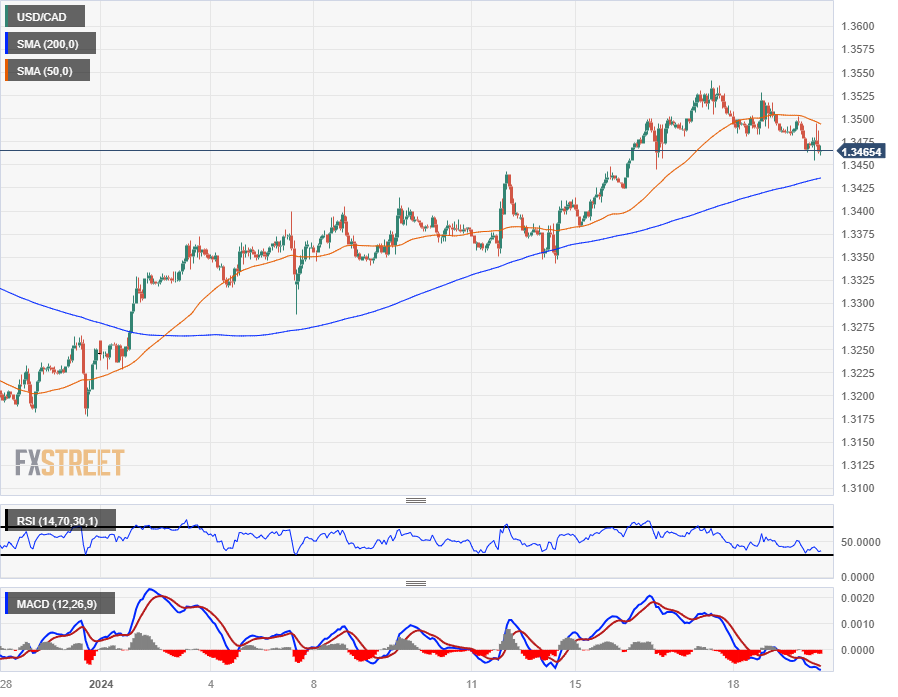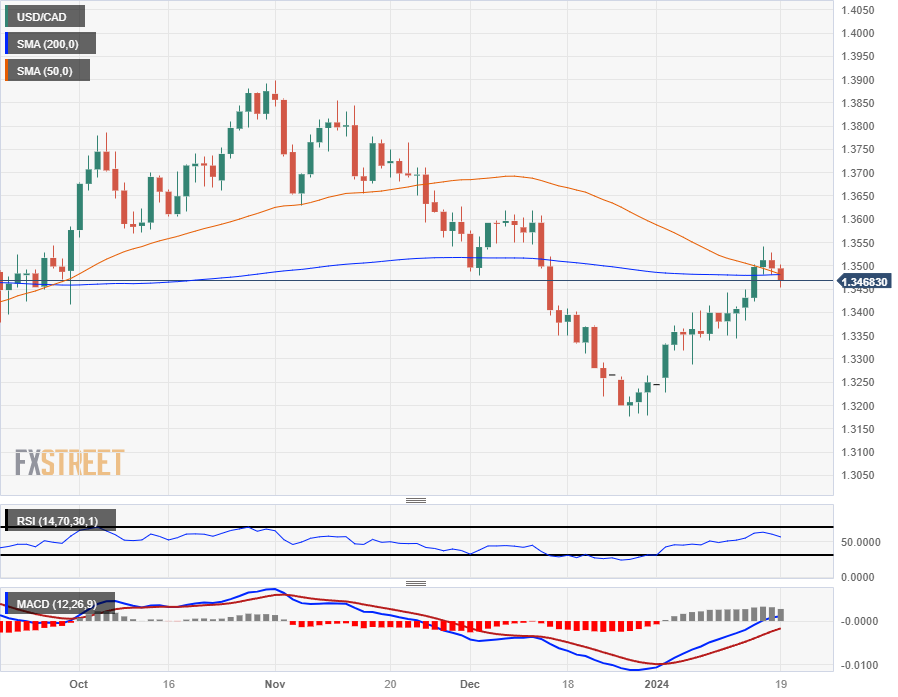Canadian Dollar rebounds on Friday, catches a ride on Crude Oil
- Canadian Dollar softly up on Friday as Crude Oil rises.
- Canada Retail Sales decline more than expected, hampers topside.
- Loonie up overall on the week but still down against the US Dollar.
The Canadian Dollar (CAD) rose on Friday, bolstered by a late-week climb in Crude Oil bids as CAD traders shrugged off headwinds for the time being.
Canada saw Retail Sales decline at a faster pace than expected in November, and the Bank of Canada (BoC) was added to the growing list of global central banks that are expected to deliver rate cuts at a slower and shallower pace than investors initially hoped for.
Daily digest market movers: Canadian Dollar sheds overhang in headlines to rebound on Friday
- Canadian Retail Sales declined 0.2% in November, missing the forecast hold at 0.0% and declining further from October’s 0.7%.
- Core Retail Sales accelerated declines, printing at -0.5% versus the anticipated -0.1% and the previous 0.4% (revised down from 0.6%).
- Canada Employment Insurance Beneficiaries Change rose to 1.7% in November versus the previous 0.7%.
- US Consumer Inflation Expectations declined in January from 2.9% to 2.8%, according to the University of Michigan’s (UoM) consumer survey.
- UoM’s Consumer Sentiment Index also improved in January, rising from 69.7 to 78.8 compared to the forecast 70.0.
- US Existing Home Sales declined 1% in December, swallowing November’s 0.8% uptick.
- According to surveyed economists, the Bank of Canada is expected to start cutting interest rates much later than previously anticipated, with the majority seeing no rate changes until June at the earliest.
- Overall rate cuts are expected to be much shallower than investors initially hoped.
- Bottomless Crude Oil demand from US refineries as well as a cold snap trimming production rates see US reserves declining, bumping Crude Oil bids heading into the weekend.
Canadian Dollar price today
The table below shows the percentage change of Canadian Dollar (CAD) against listed major currencies today. Canadian Dollar was the strongest against the New Zealand Dollar.
| USD | EUR | GBP | CAD | AUD | JPY | NZD | CHF | |
| USD | -0.07% | 0.27% | -0.14% | -0.01% | 0.02% | 0.29% | 0.10% | |
| EUR | 0.06% | 0.32% | -0.08% | 0.04% | 0.08% | 0.35% | 0.16% | |
| GBP | -0.27% | -0.36% | -0.44% | -0.30% | -0.26% | 0.02% | -0.17% | |
| CAD | 0.14% | 0.08% | 0.43% | 0.13% | 0.17% | 0.45% | 0.26% | |
| AUD | 0.00% | -0.05% | 0.29% | -0.14% | 0.01% | 0.28% | 0.09% | |
| JPY | -0.01% | -0.11% | 0.26% | -0.18% | -0.04% | 0.27% | 0.09% | |
| NZD | -0.28% | -0.38% | -0.01% | -0.46% | -0.32% | -0.28% | -0.19% | |
| CHF | -0.11% | -0.16% | 0.17% | -0.26% | -0.14% | -0.06% | 0.19% |
The heat map shows percentage changes of major currencies against each other. The base currency is picked from the left column, while the quote currency is picked from the top row. For example, if you pick the Euro from the left column and move along the horizontal line to the Japanese Yen, the percentage change displayed in the box will represent EUR (base)/JPY (quote).
Technical Analysis: Canadian Dollar climbs across the board on Friday, USD/CAD sheds 1.3500
The Canadian Dollar (CAD) is in the green against all of its major currency peers on Friday, gaining around four-tenths of a percent against the Pound Sterling (GBP) and the New Zealand Kiwi (NZD), with the smallest gains of around a tenth of a percent against the Euro (EUR) and the Australian Dollar (AUD).
The US Dollar is down about a fifth of a percent against the Canadian Dollar on Friday after an intraday rejection from the 1.3500 level before testing into the 1.3450 region. Near-term momentum is seeing the USD/CAD drift back toward the 200-day Simple Moving Average (SMA) near 1.3430.
Daily candlesticks are getting hung up on the 200-day SMA just below the 1.3500 level, and the USD/CAD could see a technical rejection extend into a bearish pullback with a price floor chalked in near 1.3200.
Even if buyers find the topside momentum necessary to carry the USD/CAD over the consolidation of the 50-day and 200-day SMAs near 1.3500, there’s still a lot of ground to cover before bids can recover the last swing high set in early November near 1.3900.
USD/CAD Hourly Chart
USD/CAD Daily Chart
Canadian Dollar FAQs
What key factors drive the Canadian Dollar?
The key factors driving the Canadian Dollar (CAD) are the level of interest rates set by the Bank of Canada (BoC), the price of Oil, Canada’s largest export, the health of its economy, inflation and the Trade Balance, which is the difference between the value of Canada’s exports versus its imports. Other factors include market sentiment – whether investors are taking on more risky assets (risk-on) or seeking safe-havens (risk-off) – with risk-on being CAD-positive. As its largest trading partner, the health of the US economy is also a key factor influencing the Canadian Dollar.
How do the decisions of the Bank of Canada impact the Canadian Dollar?
The Bank of Canada (BoC) has a significant influence on the Canadian Dollar by setting the level of interest rates that banks can lend to one another. This influences the level of interest rates for everyone. The main goal of the BoC is to maintain inflation at 1-3% by adjusting interest rates up or down. Relatively higher interest rates tend to be positive for the CAD. The Bank of Canada can also use quantitative easing and tightening to influence credit conditions, with the former CAD-negative and the latter CAD-positive.
How does the price of Oil impact the Canadian Dollar?
The price of Oil is a key factor impacting the value of the Canadian Dollar. Petroleum is Canada’s biggest export, so Oil price tends to have an immediate impact on the CAD value. Generally, if Oil price rises CAD also goes up, as aggregate demand for the currency increases. The opposite is the case if the price of Oil falls. Higher Oil prices also tend to result in a greater likelihood of a positive Trade Balance, which is also supportive of the CAD.
How does inflation data impact the value of the Canadian Dollar?
While inflation had always traditionally been thought of as a negative factor for a currency since it lowers the value of money, the opposite has actually been the case in modern times with the relaxation of cross-border capital controls. Higher inflation tends to lead central banks to put up interest rates which attracts more capital inflows from global investors seeking a lucrative place to keep their money. This increases demand for the local currency, which in Canada’s case is the Canadian Dollar.
How does economic data influence the value of the Canadian Dollar?
Macroeconomic data releases gauge the health of the economy and can have an impact on the Canadian Dollar. Indicators such as GDP, Manufacturing and Services PMIs, employment, and consumer sentiment surveys can all influence the direction of the CAD. A strong economy is good for the Canadian Dollar. Not only does it attract more foreign investment but it may encourage the Bank of Canada to put up interest rates, leading to a stronger currency. If economic data is weak, however, the CAD is likely to fall.
